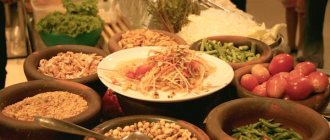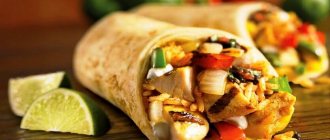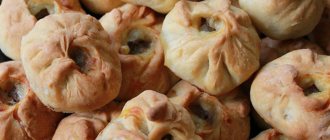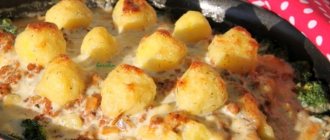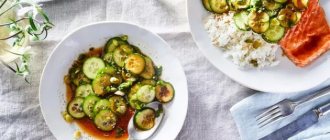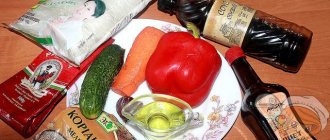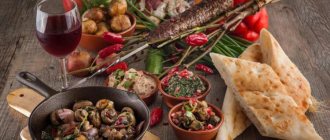Secrets of Jewish cuisine
You can learn the secrets of Jewish cuisine from this article. The basis of the cuisine is fruits, fish and dairy products. And these are healthy food products. But at the same time, everything must be prepared and consumed according to the rules of kashrut. For example, you cannot combine meat and dairy products. They must be prepared in different vessels and should also be eaten separately. In addition, you should not mix meat and fish in one dish. Combinations of milk and chicken (even in separate vessels), beef and fish, and other similar combinations should not be allowed in one meal.
Enough rules of kashrut are known, and listing them all is quite problematic. It is worth highlighting the main ones. Products prohibited for Jews include:
- animal blood;
- pork;
- meat of predators, including birds of prey and fish;
- caviar of predatory fish;
- hare meat;
- fish without scales;
- bird eggs with blood clots (however, their removal is allowed).
Among the most common foods for consumption are poultry and liver. In addition, Jews include goose fat in their diet, choosing it over chicken fat. Fish is a national dish found in the daily diet, especially pike and tuna. © https://ydoo.info/evrejskaja-kuhnja.htmlThe Jewish diet also includes dairy and plant products.
Among all foods, Jews prefer stuffed ones. The chefs have learned to make them to perfection. They can stuff meat, poultry, fish, and prepare hearty and appetizing rolls. Jews also love first courses, preferring broths and vegetable soups. Separately, we can highlight such a dish as kreplach, which is reminiscent of our dumplings stuffed with cheese or dried fruit.
Another striking feature of Jewish cuisine is a significant amount of flour products. Most often these are dough pieces that can be stored for a long time and then used for preparing pies and other dishes. There are also national confectionery delicacies, namely teiglah, lekakh, challah. They are made from wheat flour with the addition of nuts, honey, poppy seeds and raisins.
Spices are mandatory components of food. They are used carefully and in measured quantities. Jews are convinced that spices should complement a dish, and not interrupt its taste.
The most popular flour product is matzo. These are unleavened flatbreads made from flour and water that can be stored for a long time. They are consumed as bread, spread on snacks such as herring mincemeat, muhammaru (puree of walnuts and roasted peppers), hummus (spiced pea spread), and used as pie crusts.
Every Saturday Jews observe Shabbat. They prepare dishes for it on Friday evening. The traditional dish is cholent made from cereals, beans (usually beans), vegetables and meat. The dish should languish in a pot from late Friday evening, and on Saturday you can take it out and enjoy it. Challah (braided bread) is also allowed on Shabbat. By the way, in individual Jewish communities the laws of kashrut may have their own variations.
Hamantashen
Hamantashen is a traditional dish for the holiday of Purim, which Jews celebrate in the middle of the Jewish month of Adar. Purim commemorates the liberation of the Jewish people from Haman, the advisor to the King of Persia, who wanted to exterminate the Jews.
The classic recipe for hamantaschen is filled with poppy seeds, but dried and fresh fruits, chocolate, caramel and even cheese are also common. Regardless of the filling, these cookies can always be easily recognized by their triangular shape.
Jewish salads and appetizers
Salads and appetizers are not very common in Jewish cuisine. A significant place is occupied by forshmak (herring puree), as well as simply chopped herring. Jews love this delicious fish in all its forms, so there are quite a lot of recipes with it. Other types of appetizers include chopped eggs with onions (they are additionally fried in butter, vegetable oil or goose fat), radish with lard, and gehakte leber (liver paste).
Salads are mostly very simple and affordable, for example:
- beetroot (boiled and chopped beets, grated horseradish, dressing made from vegetable oil, vinegar, salt and sugar);
- potato (boiled and diced potatoes, chopped onion, dressing of ground pepper, salt, vinegar and mayonnaise);
- cucumber-egg (fresh cucumbers, green onions, egg, salt and goose fat dressing).
First and second dishes
First and second courses are the main diet. Poultry broths, veal broths and vegetable soups are common first courses. Noodles, homemade croutons and flour dressings are often added to broths. One of the most common first courses is cold beet soup. All spices are used very carefully so as not to interrupt the taste of the food. Also in demand are such types of first courses as:
- cold sweet borscht with candied and dried fruits;
- bean and potato soup;
- cold red borscht;
- pea soup with meat;
- potato soup with milk;
- milk soup with dumplings;
- barley soup.
The main courses are mostly represented by chopped rolls and stuffed dishes. Goose and chicken necks are very popular. Many tourists are inclined to believe that this is more of a ritual and a tribute to tradition than a truly favorite dish. Indeed, preparing the neck of a bird is quite intricate. First you need to remove the middle of the bird's neck so as not to damage the skin, then the bones are removed and the meat is chopped. After this, it is fried in goose fat along with flour and onions. The next step is to place the food back into the neck and fry it until a characteristic golden brown crust appears.
A special place in Israeli cuisine is given to fish (it must have scales, fins and gills, only this is considered kosher). Jews also like stuffed fish. The fillings can be anything except meat. The general name for all stuffed fish is gefilte fish. Israeli restaurants even offer fish stuffed with other fish, which is considered a gourmet dish. They also love this product marinated or grilled (musht). In total, about 15 methods of marinating fish are known, especially tuna, which is very revered.
Among the side dishes for main courses, the following are held in high esteem:
- hummus (pea puree with garlic and onions);
- falafel (soy balls);
- tahini (ground onion-tomato-sesame mixture).
One of the treasures of Jewish cuisine can be called Meorav Yerushalim. This is the name given to the roast, which is based on chicken breast and three types of chicken giblets (navel, liver and heart). The dish is seasoned with onions and spices. By the way, the seasonings used differ in different regions of the country, so the dishes turn out different, and tourists can go on a real gastronomic journey.
You can’t ignore such delicious dishes as:
- Hraime. This is any fish with scales that is baked with hot sauce.
- Lamb with couscous. It is usually baked and served with boiled porridge.
- Eggplant with chicken. In many ways, the dish is similar to a stew.
- Mafrum. These are potatoes that Jews skillfully stuff with chopped meat.
- Kugel. It resembles both a casserole and a pudding at the same time. It contains rice-pasta-potato-beetroot mixture.
Bakery
Baked goods are presented in huge quantities: lekah, khomentash, matzo, kneidlach, challah and many others. A specific feature is that most dough products are preparations for other foods that can be stored for a long time. But we cannot help but name certain flour dishes:
- Homentash. These are hearty pies that are generously stuffed with poppy seeds.
- Challah. This is a special type of bread - braided. It also contains poppy or sesame seeds. This dish is served on Saturday.
- Kneidlach. These are hearty and small-sized dumplings that are boiled in broth.
- Matzo. It is a thin and crispy sheet made from dough (water and flour).
- Matze braye. The dish consists of soaked matzo sheets, which are subsequently fried in goose fat with eggs and onions. The remaining crumbs are used to bake pancakes called macelatkes.
- Lakah. These are delicious gingerbread cookies with almond flavor.
- Latkes. This is the name for Jewish pancakes, which housewives often prepare at home.
- Mandalah. These are carved figures made from simple dough that is rolled out very thin. The figurines are fried in boiling oil and served with the first courses.
- Bagel. These are bagels made from dough that is first boiled and then baked.
- Sufganiyet. The dessert consists of donuts filled with jelly or jam.
- Hremzlach. These are our usual biscuits.
- Pancakes. This is the name of Jewish pancakes, which can be wrapped with any filling.
Preparing cholent
To prepare this dish you will need the following ingredients: 1 kilogram of beef, two glasses of beans (one glass each of white and red), half a glass of pearl barley, three onions, three medium-sized potatoes, two tablespoons of wheat flour, as well as ghee, salt and black pepper.
Rinse the beans and cover with cold water. Also rinse the barley and soak in water for 6-12 hours, and then cook in it for 10-15 minutes.
Pour flour into a plastic bag and, putting the meat cut into large pieces into it, tie it and shake it well so that the flour covers each of the meat slices.
After removing the meat from the bag, fry it in portions over high heat in a mixture of vegetable and ghee using a thick-walled saucepan. After the meat is ready, add ghee to the pan and fry the onion, pre-cut into rings, until it becomes translucent. After this, pour the pearl barley into the pan with the onions along with the water in which you cooked it. When the mixture boils, add the meat there.
Drain the beans and place them in a saucepan. Add salt and stir.
Peel the potatoes and cut them into large pieces. Place it in a saucepan, cover with warm water and bring to a boil. After this, cook over medium heat for about half an hour.
Next, reduce the heat to low and simmer the dish under the lid for about six to seven hours, periodically adding boiling water. An hour before the end of the cooking process, add salt, pepper and seasonings.
Best materials of the month
- Coronaviruses: COVID-19
- Antibiotics for the prevention and treatment of COVID-19: how effective are they?
- The most common "office" diseases
- Does vodka kill coronavirus?
- How to stay alive on our roads?
Features of drinks, desserts and sweets of Jewish cuisine
The specialties of drinks, desserts and sweets of Jewish cuisine will delight those with a sweet tooth. It’s safe to say that Israel is the best place and even a paradise for sweet tooth lovers, because its menu is very diverse. There are many desserts: eggnog, baked apples, several types of cookies, carrot and honey pies, malabi, konafa, khomentash, candied fruit. Now let's take a closer look at the most popular desserts.
A very popular dessert is tzimmes. It resembles a sweet stew. It is noteworthy that its composition differs according to the cooking region and circumstances. In particular, tsimmes can be chickpeas, beans, or carrots. By the way, this dish is considered the main dish on the table on the Jewish New Year, this is especially typical for Ashkenazi Jews. It is not difficult to make (vegetables boiled in syrup and chopped), but is considered a delicacy. Interestingly, the name “tzimmes” is translated into Russian as “the best.”
A frequent dessert is baked apples, which Jewish housewives prepare along with raisins, homemade syrup and nuts. For significant celebrations, carrot cakes with honey filling are served. Jews also love to cook hometash (poppy seed and nut cookies) at home.
Sweets can be purchased directly on the streets of Jewish cities, this is a manifestation of the so-called street food. Commonly sold are baklava (sliced cake with a layer of nuts), konafa (cookies with crushed nuts), malabi (pieces of pudding with caramel additives) and various candied fruits.
Jews keep the secrets of their drink recipes secret. Among alcohol, they prefer arak (aniseed vodka) and Israeli wines. The latter are among the finest types of alcohol, surprising with their incredible aroma and taste. The most common types include Jordan and Carmiel.
Jews usually drink alcohol only on holidays. In everyday life, each meal traditionally ends with the consumption of strong black coffee or tea.
Rugelach
This delicious crescent-shaped treat is so popular that it can be found on cafe menus from Budapest to Jerusalem to New York. American bakers often replace cream cheese-based dough with traditional yeast dough, and some recipes also use sour cream. To diversify the taste of baked goods, various fillings are added to it, for example: jam, chocolate or dried fruits.
